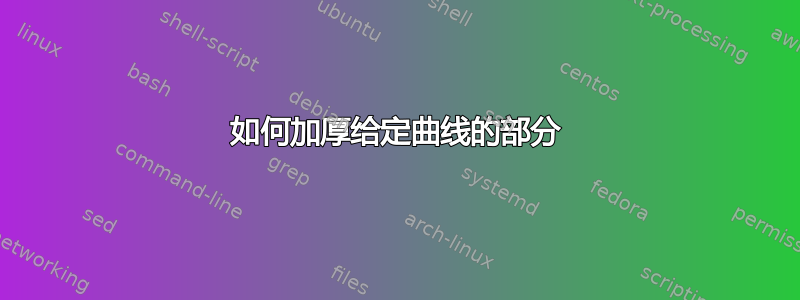
我有以下曲线和与直线的交点。我想加粗线段 $p_1p_2$ 给出的部分以及 $p_1$ 和 $p_2$ 之间的圆弧。
\documentclass[tikz,border=5pt]{standalone}
\usetikzlibrary{decorations.pathreplacing,bending}
\makeatletter
\usepackage{caption}
\usetikzlibrary{intersections,calc}
\tikzset{
on each segment/.style={
decorate,
decoration={
show path construction,
moveto code={},
lineto code={
\path [#1]
(\tikzinputsegmentfirst) -- (\tikzinputsegmentlast);
},
curveto code={
\path [#1] (\tikzinputsegmentfirst)
.. controls
(\tikzinputsegmentsupporta) and (\tikzinputsegmentsupportb)
..
(\tikzinputsegmentlast);
},
closepath code={
\path [#1]
(\tikzinputsegmentfirst) -- (\tikzinputsegmentlast);
},
},
},
}
\makeatother
\begin{document}
\clearpage
\begin{tikzpicture}
\begin{scope}[scale=2]
\draw[smooth,tension=1,]
plot coordinates{(0.6,0.9) (1,2.2) (2,-0.5) (1,-1) (1,1) (1,2.3) (1.3,-0.9)};
\draw[name path=line,smooth](0.8,-0.5) -- (1.8,1.8)
node[pos=0.39,circle,fill,inner sep=1pt] {}
node[pos=0.37, right] {$p_1$}
node[pos=0.76,circle,fill,inner sep=1pt] {}
node[pos=0.74, right] {$p_2$};
\end{scope}
\end{tikzpicture}
\end{document}
答案1
首先,既然您加载了该intersections库,我建议您实际使用它并让 PGF 自动放置节点:
\documentclass[tikz, border=5pt]{standalone}
\usetikzlibrary{intersections}
\begin{document}
\begin{tikzpicture}
\begin{scope}[scale=2]
\draw[smooth, tension=1, name path=curve]
plot coordinates{(0.6,0.9) (1,2.2) (2,-0.5) (1,-1) (1,1) (1,2.3) (1.3,-0.9)};
\draw[name path=line, smooth] (0.8,-0.5) -- (1.8,1.8);
\fill[name intersections={of=curve and line}]
(intersection-3) circle[radius=1pt] node[right] {$p_1$}
(intersection-1) circle[radius=1pt] node[right] {$p_2$};
\end{scope}
\end{tikzpicture}
\end{document}
至于特定段的样式,您可以使用fillbetweenPGFPlots 附带的库(并且还会加载该intersections库):
\documentclass[border=5pt]{standalone}
\usepackage{pgfplots}
\pgfplotsset{compat=newest}
\usetikzlibrary{pgfplots.fillbetween}
\begin{document}
\begin{tikzpicture}
\begin{scope}[scale=2]
\draw[smooth, tension=1, name path=curve]
plot coordinates{(0.6,0.9) (1,2.2) (2,-0.5) (1,-1) (1,1) (1,2.3) (1.3,-0.9)};
\draw[name path=line, smooth] (0.8,-0.5) -- (1.8,1.8);
\fill[name intersections={of=curve and line}]
(intersection-3) circle[radius=1pt] node[right] {$p_1$}
(intersection-1) circle[radius=1pt] node[right] {$p_2$};
\draw[very thick, intersection segments={of=curve and line, sequence={L2 -- L3 -- R3}}] -- cycle;
\end{scope}
\end{tikzpicture}
\end{document}





